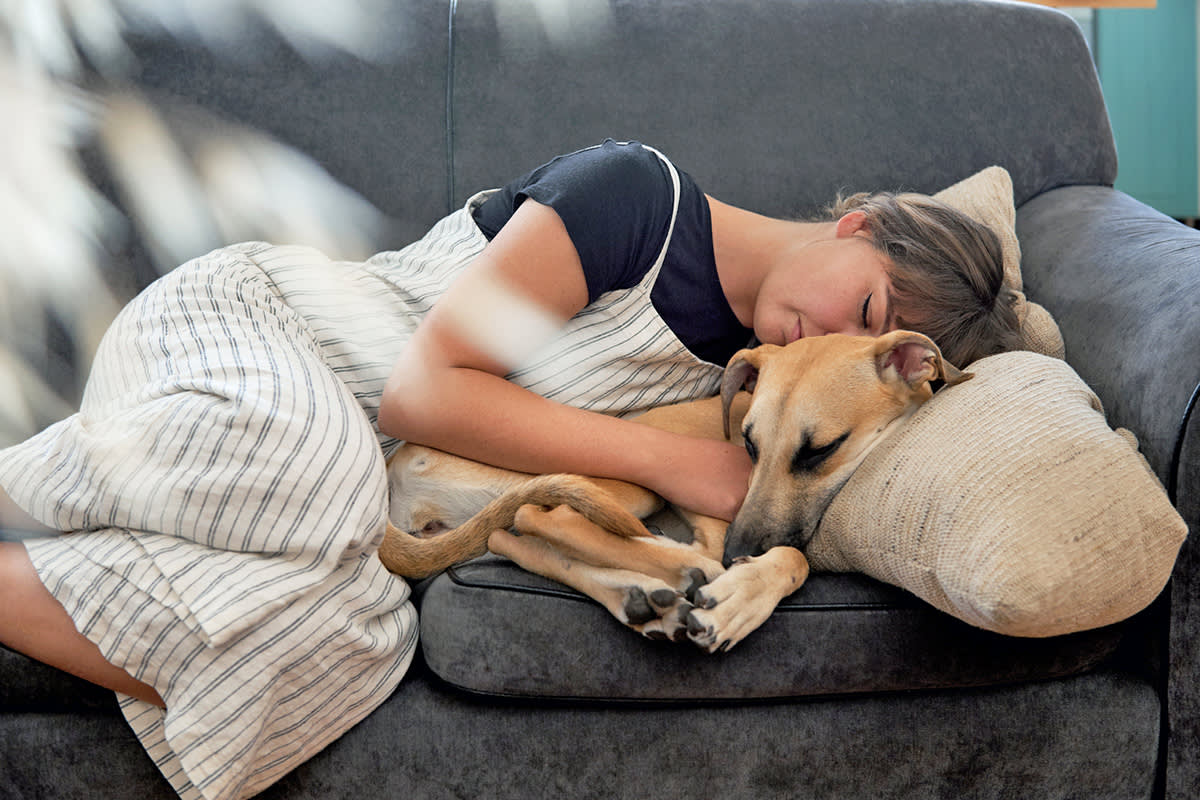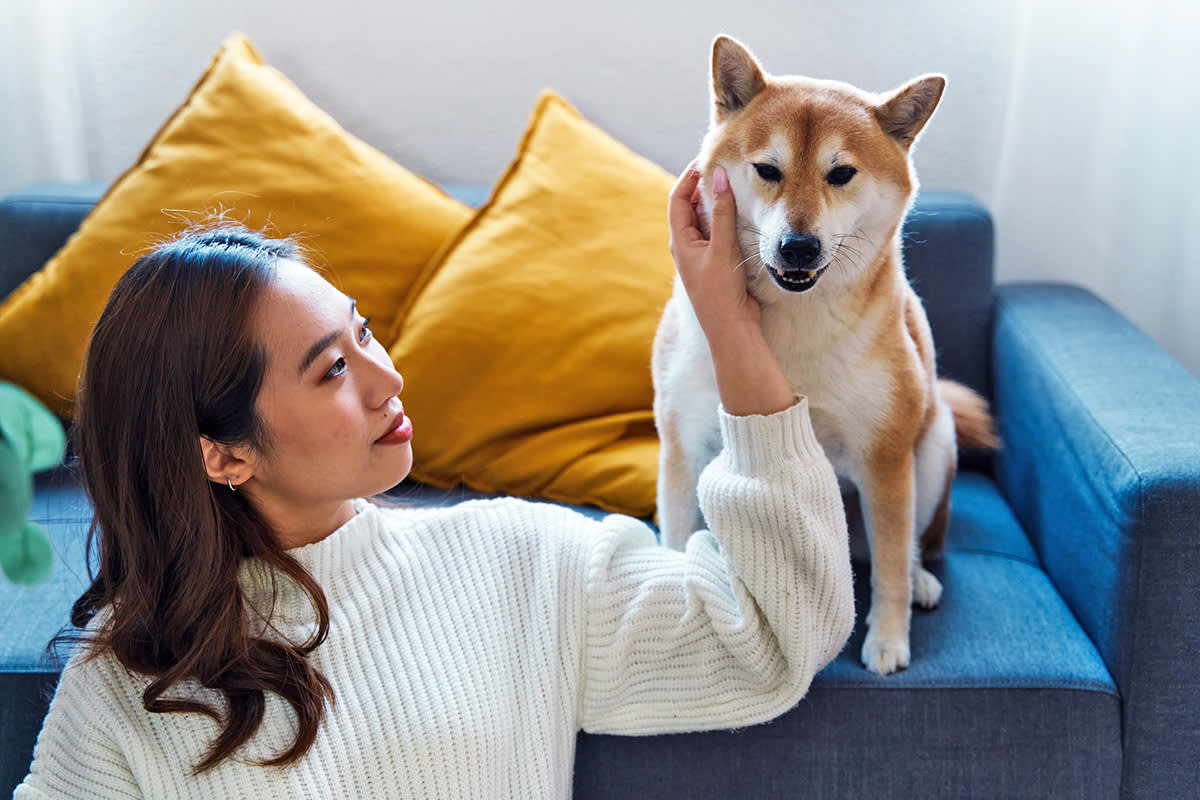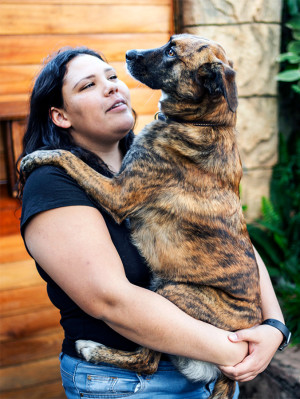Do We Rely on Our Dogs for Too Much Emotional Support?
They didn’t sign up for this.

Share Article
Violet the Golden Retrieveropens in new tab is done playing therapist. Ivy the Goldendoodleopens in new tab would like to announce that she quits. Lola the Pomeranianopens in new tab needed her own emotional support animal after listening to her human complain all week. This Shiba Inuopens in new tab is certain a mistake has been made, and this dogopens in new tab would gladly trade a bone for a moment of solitude.
Dogs put up with a lot, and that often includes their pet parent dumping all their emotions on them. Given the state of the world, and the age of raging anxiety we live in — everyone has itopens in new tab, it seems. And as the latest season of The White Lotus taught us, anti-anxiety pills are as common as cocktailsopens in new tab in some circles. For many of us, pets are yet another “cure” — or at least a temporary salve.
While the previously mentioned TikTok dogs are “protesting” in jest, via their doting pet parents who acknowledge their limits, there are pups out there who might actually be taking on too much of their person’s emotional turmoil, with not much say in the matter.
Pet parents often expect too much of our pups.
Dog trainer Matt Beisneropens in new tab at The Zen Dogopens in new tab in Austin, Texas, has seen this firsthand in his work. Beisner has had clients who bring in their dogs, hoping their pets can be trained to be better emotional support animals (ESAs).

“Almost all of the hundreds of ESA dogs I’ve seen are showing clear signs of compounding stress,” he says. “Our reliance on them to ‘support’ us seems to bear little concern of how their service to us impacts them.”
Beisner says one common example is to see dogs who aren’t comfortable in certain environments being taken to public places with their humans for emotional support. Like someone who takes their dog with them to a crowded place they need to go because they feel better with them by their side even if their pup doesn't really like being around a lot of people either. The dog often hides under something, stands behind their person, or makes “repeated attempts to get their human’s eye contact as an ask for ‘help,’” Beisner says. Those are all signs that the dog is being asked to fill a role they’re not comfortable with.
“I have seen many cases where ESA dogs’ nervous systems are so taxed that the dog can no longer self-regulate, rest well, socialize, or engage in healthy play,” Beisner says. “For me, it’s heartbreaking.”
Tatiana Yastremskiopens in new tab, a certified dog trainer and behavior consultant at St. Hubert’s Animal Welfare Centeropens in new tab in Madison, New Jersey. knows the feeling.
“I have also encountered clients interested in their dog being an emotional support dog for them, when the dog’s personality is clearly not conducive to offering emotional support,” she says. “[Those dogs] were either anxious, nervous, fearful, or highly aroused with an inability to focus. To expect dogs with these types of personalities to offer emotional support puts too much pressure on the dog, which in turn could lead to the dog making a bad decision.”
What’s a worst-case scenario?
If you’re relying too much on your pup for your emotional needs, and it’s stressing them out, you could see symptoms like loss of appetite, restlessness, irritability, excessive licking, reactivity, or even obsessive compulsive disorder (OCD)-type behavior, Beisner says.
Yastremski notes that in her one-on-one sessions with clients, she often consults on cases where dogs have bitten people who did not heed the dog’s warnings, like barking, growling, or air snapping. “These dogs were either on someone’s lap being pet or kissed and hugged good night when already laying on the dog bed,” she says.
Again, it’s not that your pet doesn’t have affection for you, but it might be that they’re emotionally out of steam and would simply like time to decompress alone for a while.
So, how can we lean on our dogs?
For some dogs, life as a psychiatric service dog is a joy.
“There are plenty of examples of dogs in service or working dynamics with humans who not only seem to enjoy the experience but thrive in it,” Beisner says, noting that this usually is when the work suits the dog’s temperament, personality, sociability, and similar factors.
As for our everyday pets, it’s silly to think they’re not a source of comfort; of course they are. They do, after all, have a reputation for being just about the best thing ever. Take this studyopens in new tab, which found that dogs significantly decreased patient anxiety in an emergency room. Those dogs were trained, of course, while most of our own pups are trained only to understand that the word “treat” means they’ve been a very good boy or girl.
This doesn’t mean that we can’t lean on our pups for comfort, though: Petting your dog has shown to reduce levels of the stress hormone cortisol and give a boost of feel-good oxytocin, after all. One of the most common ways this plays out is when you return home: “Their enthusiastic greeting can be just what the doctor ordered, because seeing your dog running towards you makes you forget about the challenges of the day, even if just for a moment,” Yastremski says.
But the key is making sure that your dog enjoys the activity just as much as you do. That might be snuggling or it might be an invigorating game of fetch; every pup’s an individual, just like you. Another option?
“For some people,” Yastremski says, “taking their dog for a walk or a hike could be all the emotional support they need.”
How do you define an official ESA?
Psychiatric service dogs (PSD) exist — and for good reason — but per the ADA’s siteopens in new tab, they have very specific trainingopens in new tab. That’s not the same as slapping an $8 Amazon vest that says “emotional support dog” on your pup and expecting them to absorb all your heartache, even if they are an angel in canine form. And you can get a letter from a mental-health professional to get an ESA approved by a landlord, but again, that’s not the same as a PSD.
“Service dogs are trained to perform tasks specific to their handler’s disability,” but that’s not the case for emotional support dogs, says Yastremski. “Being an emotional support dog could be stressful to a dog if their personality is not conducive to providing that support. For example, if a dog who is afraid of unfamiliar people is repeatedly put in situations where crowds of people are par for the course, the dog’s stress level is likely to increase.”
According to the ADA National Networkopens in new tab, “emotional support animals provide companionship, relieve loneliness, and sometimes help with depression, anxiety, and certain phobias” — but, unlike recognized service animals, they do not have specific training.
One could also argue that all dogs provide some level of emotional support, and the term gets thrown around a lot in today’s culture. It’s gotten to the point that anything that helps us get through the day qualifies; we even have emotional support sandwiches opens in new tab and water bottles.opens in new tab
But is this fair to your pup? Experts say absolutely not.
“Humans generally expect too much from dogs, emotional support being a key element,” Yastremski says. “We expect dogs to tolerate things we won’t tolerate ourselves.”
One example Yastremski offers: You startle your dog awake in order to give them a hug or a kiss. “Although these actions may make us humans feel better, they may not be something that a dog necessarily enjoys,” she says. “Dogs are sentient beings with likes, dislikes, and preferences. These kinds of behaviors put a lot of pressure on dogs who are not trained to handle them.”
What if my dog really does offer emotional support?
Of course, dogs recognize when we’re sad, and they often serve as a source of comfort. But there’s a difference between accepting the kindness of a paw on your hand and expecting them to absorb all the anxiety you bring home from work each day.
To better understand this dynamic, it might be good to revisit early aughts cinema (stick with us).
In movies like Elizabethtown and Garden State, there lived an archetype called the manic pixie dream girlopens in new tab. This character was a fun, delightful person with a sense of enchantment and whimsy who existed only to help the male protagonist figure out his life. The manic pixie dream girl herself had no purpose, save helping some doofus understand himself better. The lesson? Don’t let your pup be a manic pixie dream dog (even if they are adorably whimsical). They have their own life, and they deserve to live it.
In a video on TikTokopens in new tab, dog trainer Kristina Rapson says “many dogs are not able to take on the emotional luggage” that is put upon them, and she suggests that pet parents should take a step back and ask themselves if they’re relying on their dogs for their emotional needs. “If the answer is yes, that’s where you have to seriously consider finding those needs to get met somewhere else,” she says in the video.
Your dog is an integral part of your life, and their exercise and pee needs are the perfect excuse to skip out on social plans. But they can’t exist only to be a sponge that soaks up all your emotional spillover.

Marti Trgovich
Marti Trgovich is a writer specializing in pets and wildlife. She has written about animals for National Geographic, The Washington Post, Newsweek, and other publications, and she spent nearly a decade as an editor at The Dodo. Her favorite animals are guinea pigs, sheep, and small, saucy senior dogs.
Related articles
What’s an Emotional Support Animal? Your Guide to Support Animals and Dogs
Here’s everything you need to know about ESAs.
![Person holding a corgi, shot from behind]()
Flying with An Emotional Support Animal
Are ESA alpacas and peacocks mocking people with real disorders? A service-dog owner and flight attendant get real.
![Young woman holding her large dog in her arms outdoors.]()
What to Do When Your Dog Is Even More Anxious Than You Are
Did you get a dog for emotional support and now they are the one who needs it?
![A redheaded woman in a black hat and sunglasses holding her pug dog under her arm as well as two boarding passes and her passport in an airport hallway]()
10 Places Where Your ESA Is — and Is Not — Allowed
Not every public place allows ESAs — but there are ways to advocate for yourself and your needs when your pup or other ESA is not on the guest list.
Can Dogs Sense When You’re Sad?
It certainly seems like it sometimes.
![]()
5 Places Where Therapy Dogs Do Their Best Work
At airports, hospitals, schools, and more, therapy dogs make things better.








